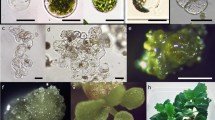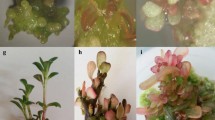Abstract
In plant biotechnology, protoplasts are a versatile tool since they are very helpful for both fundamental biology studies and for genetic improvement and genome editing studies. In many plant species, however, reproducible regeneration from protoplasts continues to be a bottleneck. In the present study, we report the development of an efficient method for protoplast isolation, and plant regeneration in Angelica gigas via indirect somatic embryogenesis. Protoplasts were isolated from embryogenic callus using an enzyme mixture of 1.0% Viscozyme® L + 1% Celluclast® 1.5 L + 0.5% Pectinex® XXL with 7 h treatments. Initially, protoplasts were cultured in MS, modified MS (NH4NO3-free medium), and KM media, and viability and cell division data showed the MS medium was suitable for protoplast culture. Subsequently, the thin alginate layer method was applied to the protoplast culture at an optimal density of 1 × 106 cells per mL− 1 and verified the effect of 2,4-D (0.1, 0.5, and 1.0 mg L− 1) alone, and 2,4-D (0.5, and 1.0 mg L− 1) in combination with BA (0.1 and 0.5 mg L− 1) or KN (0.1 and 0.5 mg L− 1) on cell division, micro-callus formation. MS medium supplemented with 1.0 mg L− 1 2,4-D and 0.1 mg L− 1 KN induced optimal cell division, callus formation, and subsequent induction of somatic embryogenesis from the callus. The somatic embryos germinated and converted into plantlets upon transferring to the MS basal medium. This method of Angelica gigas protoplast regeneration can be used for the genetic improvement of this plant.
Key message
The primary goal of the current study was to develop plant regeneration in Angelica gigas using protoplast culture, which could be valuable for the genetic improvement of this significant medicinal plant.








Similar content being viewed by others
Data availability
Data will be made available on reasonable request.
References
Ali M, Mujib A, Zafar N, Tonk D (2018) Somatic embryogenesis, biochemical alterations and synthetic seed development in two varieties of coriander (Coriandrum sativum L). Adv Hortic Sci 32:239–248. https://doi.org/10.13128/ahs-22287
Anthony P, Otoni W, Brian Power J, Lowe KC, Davey MR (1999) Protoplast isolation, culture, and plant regeneration from Passiflora. In: Hall RD (ed) Plant cell culture methods. Humana Press Inc., Totowa, NJ, pp 169–181
Aoyagi H (2011) Application of plant protoplasts for the production of useful metabolites. Biochem Eng J 56:1–8. https://doi.org/10.1016/j.bej.2010.05.004
Dai XM, Xiao W, Huang X, Zhao JT, Chen YF, Huang XL (2010) Plant regeneration from embryogenic cell suspensions and protoplast dessert banana cv. ‘Da Jiao’ (Musa paradisiacal ABB Linn.) Via somatic embryogenesis. In Vitro Cell Dev Biol – Plant 46:403–410. https://doi.org/10.1007/s11627-010-9314-7
Davey MR, Anthony P, Brian Power J, Lowe KC (2005) Plant protoplasts: status and biotechnological perspectives. Biotechnol Adv 23:131–171. https://doi.org/10.1016/j.biotechadv.2004.09.008
Duquenne B, Eeckhaut T, Werbrouck S, Van Huylenbroeck J (2007) Effect of enzyme concentrations on protoplast isolation and protoplast culture Spathiphyllum and Anthurium. Plant Cell Tissue Organ Cult 91:165–173.https://doi.org/10.1007/s11240-007-9226-3
Duties D, Fejar O, Hadlaczky G, Koncz, Lazar GB, Horvath G (1980) Intergeneric gene transfer mediated by plant protoplast fusion. Molec Gen Gent 179:283–288. https://doi.org/10.1007/BF00425455
Golds TJ, Babczisnky J, Rauscher G, Koop HU (1992) Computer controlled tracking of single cell development in Nicotiana tabacum L. and Hordeum vulgare L. protoplasts embedded in agarose/alginate films. J Plant Physiol 140:582–587. https://doi.org/10.1016/S0176-1617(11)80793-5
Grzebelus E, Szklarczyk M, Baranski R (2012) An improved protocol for plant regeneration from leaf- and hypocotyl-derived protoplasts of carrot. Plant Cell Tissue Organ Cult 109:101–109. https://doi.org/10.1007/s11240-011-0078-5
Han JE, Lee HS, Lee H, Cho H, Park SH (2022) Embryogenic stem cell identity after protoplast isolation from Daucus carota and recovery of regeneration ability through protoplast culture. Int J Mol Sci 23:11556. https://doi.org/10.3390/ijms231911556
He Z, Wang Y, Chen Y, Geng F, Jiang Z, Li X (2023) Angelica Gigas Nakai: an overview on its chemical composition and pharmacological activity. Biochem Syst Ecol 111:104717. https://doi.org/10.1016/j.bse.2023.104717
Jeong YY, Lee HY, Kim SW, Noh YS, Seo PJ (2021) Optimization of protoplast regeneration in the model plant Arabidopsis thaliana. Plant Methods 17:21. https://doi.org/10.1186/s13007-021-00720-x
Kang JW, Cho HE, Choi HM, Lee IC (2022) Anti-wrinkle properties of Angelica Gigas Nakai root extracts using mineral-rich water. J Cosmet Dermatol 22:328–334. https://doi.org/10.1111/jocd.15017
Kanwar K, Bhardwaj A, Deepika R (2009) Efficient regeneration of plantlets from callus and mesophyll derived protoplasts of Robinia pseudoacacia L. Plant Cell Tissue Organ Cult 96:95–103. https://doi.org/10.1007/s11240-008-9465-y
Kao KN, Michayluk MR (1974) A method for high-frequency intergeneric fusion of plant protoplasts. Planta 115:355–367. https://doi.org/10.1007/BF00388618
Kielkowska A, Grzebelus E, Lis-Krzyscin A, Mackowska K (2019) Application of the salt stress to the protoplast cultures of the carrot (Daucus carota L.) evaluation of the response of regenerants to soil salinity. Plant Cell Tissue Organ Cult 137:379–395. https://doi.org/10.1007/s11240-019-01578-7
Kirti PB (1988) Somatic embryogenesis in hypocotyl protoplast culture of rapeseed (Brassica napus L). Plant Breed 100:222–224. https://doi.org/10.1111/j.1439-0523.1988.tb00243.x
Ko JM, Ju J, Lee S, Cha HC (2006) Tobacco protoplast culture in a polymethylsiloxan-based microfluidic channel. Prtotoplasma 227:237–240. https://doi.org/10.1007/s00709-005-0142-2
Lee EK, Jin YW, Park JH, Yoo YM, Hong SM, Amir R, Yan Z, Kwon E, Elfick A, Tomlinson S, Halbritter F, Waibel T, Yun BW, Loake GJ (2010) Cultured cambial meristematic cells as source of natural products. Nat Biotechnol 28:1213–1217. https://doi.org/10.1038/nbt.1693
Lian YJ, Lin GZ, Zhao XM, Lim HT (2011) Production and genetic characterization of somatic hybrids between leaf mustard (Brassica juncea) and broccoli (Brassica oleracea). Vitro Cell Dev Biol-Plant 47:289–296. https://doi.org/10.1007/s11627-011-9355-6
Lin CS, Hsu CT, Yang LH, Lee LY, Fu JY, Cheng QW, Wu FH, Hsiao HCW, Zang Y, Zhang R, Chang WJ, Yu CT, Wang W, Liao LJ, Gelvin SB, Shih MC (2018) Application of protoplast technology to CRISPR/Cas9 mutagenesis: from single -cell mutation detection to mutant plant regeneration. Plant Biotechnol J 16:1295–1310. https://doi.org/10.1111/pbi.12870
Lu J, Jiang C, Schell TD, Joshi M, Raman JD, Xing C (2022) Angelica gigas: signature compounds, in vivo anticancer, analgesic, neuroprotective and other activities, and the clinical translation challenges. Am J Chinese Med 50:1475–1527. https://doi.org/10.1142/S0192415X2250063X
Mackowska K, Jarosz A, Grazebelus E (2014) Plant regeneration from leaf-derived protoplasts within the Daucus genus: effect of different conditions in alginate embedding and phytosulfokine applications. Plant Cell Tissue Organ Cult 117:241–252. https://doi.org/10.1007/s11240-014-0436-1
Miura Y, Tabata M (1986) Direct somatic embryogenesis from protoplasts of Foeniculum vulgare. Plant Cell Rep 5:310–313. https://doi.org/10.1007/BF00269830
Mujib A, Tonk D, Ali M (2014) Plant regeneration from protoplasts in Indian local Coriandrum sativum L.: scanning electron microscopy and histological evidences for somatic embryogenesis. Plant Cell Tissue Organ Cult 117:323–334.https://doi.org/10.1007/s11240-014-0442-3
Mukami A, Juma BS, Mweu C, Ngugi M, Oduor R, Mbinda WM (2022) Plant regeneration from leaf mesophyll derived protoplasts of cassava (Manihot esculenta Crantz). PLoS ONE 17:e0278717. https://doi.org/10.1371/journal.pone.0278717
Murashige T, Skoog F (1962) A revised medium for rapid growth and bioassays with Tobacco tissue cultures. Physiol Plant 15:473–497. https://doi.org/10.1111/j.1399-3054.1962.tb08052.x
Okamura M, Hayashi T, Miyazaki S (1984) Inhibiting effect of ammonium ion in protoplast culture of some Asteraceae plants. Plant Cell Physiol 25:281–286. https://doi.org/10.1093/oxfordjournals.pcp.a076712
Pati PK, Sharma M, Ahuja PS (2005) Extra thin alginate film: an efficient technique for protoplast culture. Protoplasma 226:217–221. https://doi.org/10.1007/s00709-005-0096-4
Pujari I, Thomas A, Rai PS, Satyamoorthy K, Babu VS (2021) Cell size: a key determinant of meristematic potential in plant protoplasts. aBIOTECH 2:96–104. https://doi.org/10.1007/s42994-020-00033-y
Ranaware AS, Kunchge NS, Lele SS, Ochatt SJ (2023) Protoplast technology and somatic hybridization in the family Apiaceae. Plants 12:1060. https://doi.org/10.3390/plants12051060
Reed KM, Bargmann BOR (2021) Protoplast regeneration and its use in new plant breeding technologies. Fort Genome Ed 3:734951. https://doi.org/10.3389/fgeed.2021.734951
Ren JP, Dickson MH, Earle ED (2000) Improved resistance to bacterial soft rot by protoplast fusion between Brassica rapa and B. Oleracea. Theor Appl Genet 100:810–819
Reyna-Llorens I, Ferro-Costa M, Burgess SJ (2023) Plant protoplast in the age of synthetic biology. J Exp Bot 74:3821–3832. https://doi.org/10.1093/jxb/erad172
Rhee HS, Cho HY, Son SY, Yoon SYH, Park JM (2010) Enhanced accumulation of decursin and decursinol angelate in root cultures and intact roots of Angelica Gigas Nakai following elicitation. Plant Cell Tiss Organ Cult 101:295–302.https://doi.org/10.1007/s11240-010-9688-6
Sahab S, Hayden MJ, Mason J, Spangenberg G (2019) Mesophyll protoplasts and PEG-mediated transfections: Transient assay and generation of stable transgenic canola plants. In Methods in Molecular Biology, Humana Press, New York, NY, USA, Volume 1864, pp. 131–152. https://doi.org/10.1007/978-1-4939-8778-8_10
Sheahan MB, Rose RJ, McCurdy DW (2007) Actin-filament-dependent remodeling of the vacuole in cultured mesophyll protoplasts. Protoplasma 230:141–152. https://doi.org/10.1007/s00709-006-0236-5
Song YR, Jang B, Lee SM, Bae SJ, Bak SB, Kim YW (2022) Angelica Gigas Nakai and its active compound decursin, inhibit cellular injury as an antioxidant by the regulation of AMP-activated protein kinase and YAP singling. Molecules 27:1858. https://doi.org/10.3390/molecules27061858
Sowndhararajan K, Kim S (2017) Neuroprotective and cognitive enhancement potentials of Angelica Gigas Nakai root: a review. Sci Pharm 85:21.https://doi.org/10.3390/scipharm85020021
Stelmach K, Grzebelus E (2023) Plant regeneration from protoplast of Pastinaca sativa L. via somatic embryogenesis. Plant Cell Tissue Organ Cult 153:205–217. https://doi.org/10.1007/s11240-023-02461-2
Sun Y, Zhang X, Nie Y, Guo X (2005) Production of fertile somatic hybrids of Gossypium hirsutum plus G. Bickki and G. Hirsutum plus G. Stockii via protoplast fusion. Plant Cell Tissue Organ Cult 83:303–310. https://doi.org/10.1007/s11240-005-7770-2
Tomiczak K, Mikula A, Sliwinska E, Rybczynski JJ (2015) Autotetraploid plant regeneration by indirect somatic embryogenesis from leaf mesophyll protoplasts of diploid Genetiana decumbens L.f. In Vitro Cell Dev Biol – Plant 51:350–359. https://doi.org/10.1007/s11627-015-9674-0
Tu L, Subburaj S, Lee K, Jeon Y, Yan F, Yao J, Kim YS, Koo OJ, Lee GJ (2023) Optimized regeneration of Petunia protoplast and its association with tissue identity regulators. Horticulturae 9:216. https://doi.org/10.3390/horticulturae9020216
Wang J, Sun Y, Yan S, Doud MK, Zhu S (2008) High frequency plant regeneration from protoplasts in cotton via somatic embryogenesis. Biol Planta 52:616–620. https://doi.org/10.1007/s10535-008-0121-5
Winnicki K (2020) The winner takes it all: auxin-the main player during plant embryogenesis. Cells 9:606. https://doi.org/10.3390/cells9030606
Xia G (2009) Progress of chromosome engineering mediated by asymmetric somatic hybridization. J Genet Genomics 36:547–556. https://doi.org/10.1016/S1673-8527(08)60146-0
Xiao I, Zhang L, Yang G, Zhu H, He Y (2012) Transcriptome of protoplasts reprogrammed into stem cells in Physcomitrella patens. PLoS ONE 7:e35961. https://doi.org/10.1371/journal.pone.0035961
Yue JJ, Yuan JL, Wu FH, Yuan YH, Cheng QW, Hsu CT, Lin CS (2021) Protoplasts: from isolation to CRISPR/Cas genome editing application. Front Genome Ed 3:717017. https://doi.org/10.3389/fgeed.2021.717017
Zhaban B, Maisch J, Nick P (2013) Dynamic actin controls polarity induction de novo in protoplasts. J Integr Plant Biol 55:142–159. https://doi.org/10.1111/jipb.12001
Zhao J, Morozova N, Williams L, Libs L, Avivi Y, Grafi G (2001) Two phases of chromatin decondensation during dedifferentiation of plant cells: distinction between competence for cell fate switch and a commitment for S phase. J Biol Chem 22:22772–227728. https://doi.org/10.1074/jbc.M101756200
Acknowledgements
H.S.L and J.E.H. were supported by the Brain Korea (BK) 21 Plus Program. HNM was supported by the Brain Pool Program of the National Research Foundation of Korea (Grant No. 2022H1D3A2A02056665).
Funding
The work was supported by grants from the National Research Foundation of Korea (No. NRF-2020R1A2C2102401) and the Korea Research Institute of Bioscience and Biotechnology (KGM-5282331).
Author information
Authors and Affiliations
Contributions
H.S.L and J.E.H contributed to experiments and data acquisition. E.Y.J., S.W.K., H.J.K, G.M.L., and H.S.L. in procuring material, interpretation of data, and intellectual content. S.Y.P. contributed to the conceptualization and design of the study. H.N.M. helped in the interpretation of data and writing of the manuscript. All the authors have read and approved the final version of the manuscript.
Corresponding authors
Ethics declarations
Conflict of interest
The authors declare no conflict of interest.
Additional information
Communicated by Francisco de Assis Alves Mourão Filho.
Publisher’s Note
Springer Nature remains neutral with regard to jurisdictional claims in published maps and institutional affiliations.
Rights and permissions
Springer Nature or its licensor (e.g. a society or other partner) holds exclusive rights to this article under a publishing agreement with the author(s) or other rightsholder(s); author self-archiving of the accepted manuscript version of this article is solely governed by the terms of such publishing agreement and applicable law.
About this article
Cite this article
Lee, HS., Han, JE., Jie, E.Y. et al. Isolation, culture of protoplasts of Angelica gigas Nakai and regeneration of plants via somatic embryogenesis. Plant Cell Tiss Organ Cult 156, 40 (2024). https://doi.org/10.1007/s11240-023-02666-5
Received:
Accepted:
Published:
DOI: https://doi.org/10.1007/s11240-023-02666-5




